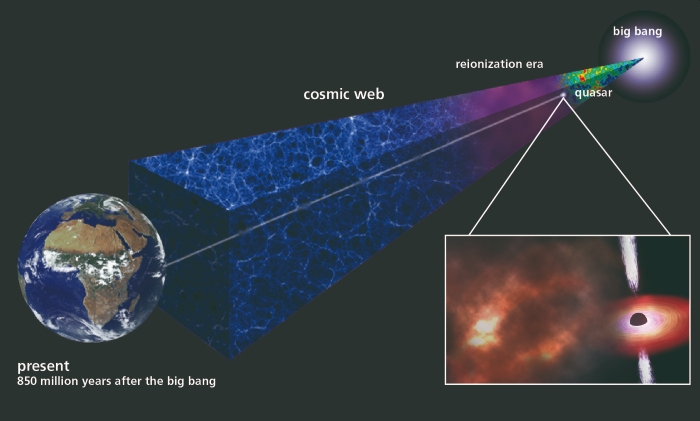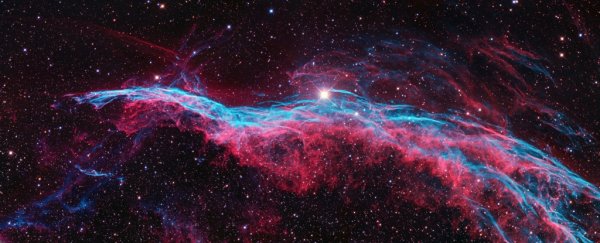When we think about the formation of the entire freaking Universe, one of the biggest questions concerns the birth of the very first stars. It's thought that stars began appearing in the first 100 million years after the Big Bang, and we've seen some really old stars; but the processes that created them from the primordial Universe soup are a big mystery.
But a gas cloud in the distant Universe has just given us a big clue. It's so far away, light from this cloud has taken nearly 13 billion years to arrive, meaning we're seeing the cloud as it was when the Universe was roughly 850 million years old - a mere blip of its current lifespan.
That cloud looks rather similar to younger gas clouds filled with elements that were forged in stars and spewed out into space in a series of explosions as those stars died. This indicates there would have been stars around that had already lived and died by 13 billion years ago.
Not just one generation, either. Based on the chemical abundances in this ancient gas cloud, at least two generations of stars had to form, live, and die to produce the chemical signature we're seeing.
It's a real dilly of a pickle for our models of star formation, and it was discovered entirely by accident.
Astronomer Eduardo Bañados of the Max Planck Institute for Astronomy and colleagues were looking at distant quasars - galaxies with extremely bright active nuclei, or cores. When the team noticed something odd about the light from a quasar called P183+05, around 13 billion light-years away, they decided to take a closer look.
It didn't take long before they realised that the odd signatures in the light were from a cloud of gas and dust near the quasar, through which some of the quasar's light was being filtered, dampening some of the wavelengths.
 (Max Planck Institute for Astronomy)
(Max Planck Institute for Astronomy)
Because different wavelengths of light are blocked by different elements, this also provided clues as to the composition of the cloud.
"After we were convinced that we were looking at such pristine gas only 850 million years after the Big Bang," said astronomer Michael Rauch of the Carnegie Institution of Science, "we started wondering whether this system could still retain chemical signatures produced by the very first generation of stars."
In the very early Universe, there wasn't a lot of variety. Just after the Big Bang, the Universe was mostly filled with hydrogen and helium. It wasn't until the first stars came along that more elements started to proliferate.
In their cores, stars fused hydrogen into helium, then helium into carbon, and so forth, with the more massive stars able to fuse nuclei all the way up to iron. When such stars reach the end of their lives and go supernova, the extreme conditions of these explosions can, in turn, create heavier elements.
These are taken up into new generations of stars - thus, the more metals there are in a star, the younger its generation is likely to be. And those signatures can also be used to tell the age of the gas between the stars - the interstellar medium.
Which brings us back to that super-old gas cloud. Something of a holy grail in cosmology is finding the chemical fingerprints of the very first generation of stars, known as Population III. The team thought that their gas cloud might have them.
So, they analysed the metallicity and relative chemical abundances in the cloud, based on spectra separated out from the light of the quasar.
As expected, the cloud had low metallicity, consistent with its age. But the relative chemical abundances had no evidence of being enriched by Population III stars. Rather, they were startlingly similar to those of much younger gas clouds enriched by Type Ia supernovae.
What that means is that another generation of stars separates the cloud from Population III stars - and, since Type Ia supernovae generally take around a billion years… well. We have a discrepancy.
That puts a curious constraint on the life cycles of early stars, which is going to be an interesting puzzle to solve. But there's other evidence to suggest that the early Universe is a pretty precocious place - such as a whole bunch of supermassive black holes that we don't think could have formed so quickly.
If this finding checks out, maybe it's time to give the cosmological models a do-over.
Meanwhile, the team is continuing to search for clues.
"It is exciting that we can measure metallicity and chemical abundances so early in the history of the Universe, but if we want to identify the signatures of the first stars we need to probe even earlier in cosmic history," Bañados said.
"I am optimistic that we will find even more distant gas clouds, which could help us understand how the first stars were born."
The research is due to be published in The Astrophysical Journal, and is available on arXiv.
